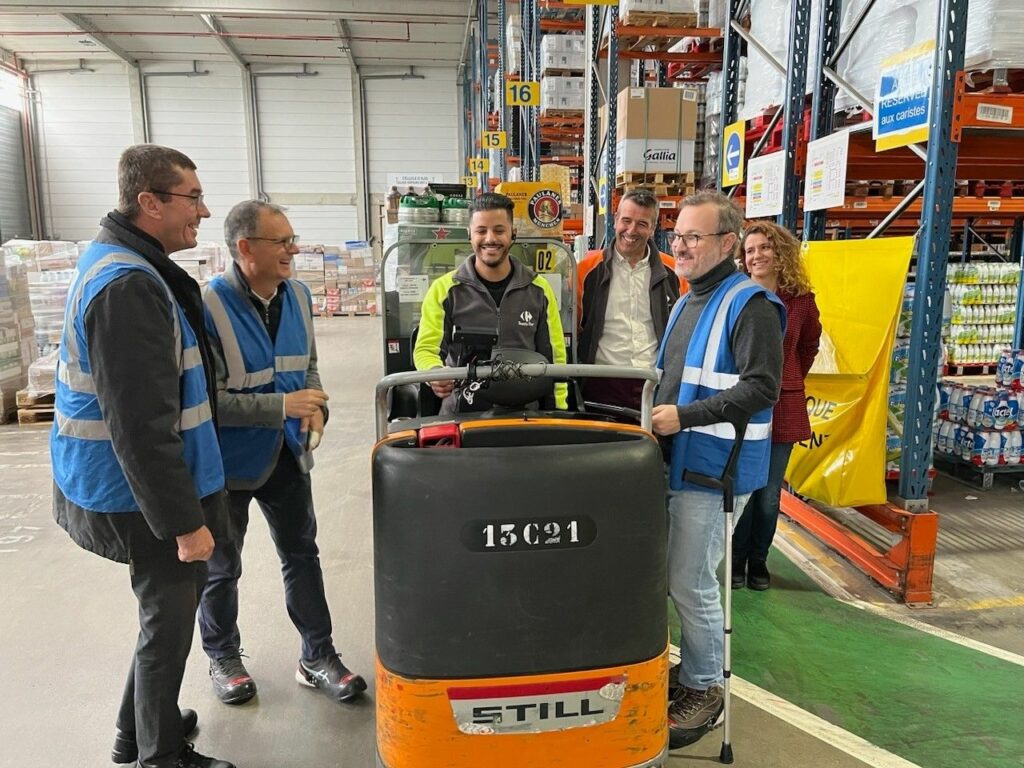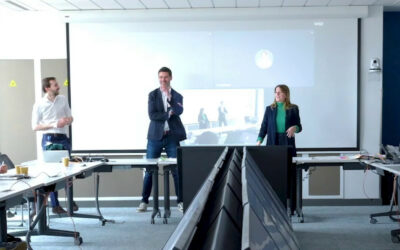EOL is our new warehouse picking solution. It unleashes enhanced autonomy and efficiency for operators, optimizing our supply chain and boosting our customer satisfaction. By blending advanced technology with user-centric design, EOL is reshaping warehouse operations.
Every day in our warehouses, millions of packages are prepared and sent out to our stores. Until now, our picking operators mainly used voice recognition, whereby they received preparation orders from a headset and validated them vocally.
Using this solution, pickers had little autonomy and decision-making in their preparations. The solution lacked flexibility. They had no vision of the picking locations they were supposed to go to. Therefore they could not anticipate the constitution of their pallet, causing issues of stability later on during transportation.
Furthermore, as the solution was only vocal and misunderstandings were quite common, pickers could be stuck in their preparation if the machine didn’t understand the order that was given. For example, when a picker said the number “42” the speech recognition sometimes heard “Carambar”, which is a French famous candy whose pronunciation is quite close to the number.
EOL: the new deal
This fully vocal solution didn’t necessarily meet our needs. We wanted to provide our pickers with mobile devices so they would have autonomy and visibility on their preparations. It was also necessary to offer more mobility and better ergonomics to our collaborators, thus facilitating their daily work.
So we decided to remedy this by creating our own solution… and came up with EOL: “Evolution Opérations Logistiques” (Evolution of Logistics Operations).
With EOL, we wanted to give the power back to the users. We’ve gone from 100% voice commands with a wired headset to a visual and vocal solution. As a user, if the device doesn’t understand me or I’m not comfortable hearing the voice all day long, I can do any action that is required directly on the device’s screen.
EOL is boosting the preparation reliability. Stores’ reclamations have decreased by 1%. It may seem a small percentage, but in retail, it’s a lot! It has a direct impact on customer satisfaction. In other words, warehouses that offer better service to our stores mean that our stores also offer better service to our customers.

Bringing new devices into warehouses
EOL isn’t only about features, it is also about new equipment! At the beginning of the project, we started with classic professional devices. Unfortunately, we found some drawbacks: heavy equipment, bloated custom Android interfaces, and incompatibilities with voice recognition. Therefore, we decided to think outside the box with new kinds of devices. Our number one priority was to have very light equipment.
That’s why we came up with a brand-new bone conduction headset, which no longer isolates pickers from their environment. They can hear ambient sounds as much as voice indications. A huge plus for safety!
Regarding mobile devices, we chose the Samsung XCover 5 enterprise edition, which looks just like a regular smartphone; because it actually is! The only difference is it is a semi-rugged device, a necessity for warehouses with sometimes challenging conditions. For example, when a picker is preparing frozen goods, the temperature can drop to -20°C.
Thanks to these new devices, we were able to enhance the solution with new features. Pickers can log in to EOL by scanning a simple QR code. They can also directly scan the products to pick without any other devices. Easy and simple!

EOL, designed by and for the pickers
To build an effective solution, we got closer to the end users, our pickers. Many iterations were necessary to meet their expectations, particularly for the voice orders, which needed to be improved.
We started our first proof of concept in April 2021 at the warehouse located in Le Rheu. It was our first pilot, but one site was not enough. The word “warehouse” refers to a place that can have several activities: ambient/chilled/frozen goods preparation, multi-customers orders preparation, just-in-time preparation, e-commerce preparation, and wine preparation for our company Maison Johanès Boubée.
These multiple activities imply different workflows and solutions. So to be sure that EOL can cover all aspects, we decided to have seven pilot sites: Le Rheu, Saint Gilles, Beychac-et-Caillau, Saint-Germain-lès-Arpajon, Saint-Vulbas, and Salon de Provence which has two warehouses, one for frozen goods and one for chilled goods. We wanted to have a truly reliable and fitting solution and thus fully satisfy our pickers.

We made EOL evolve continuously. We also did many tests related to software and hardware. Our strength was to know the business very well. It helped us to go fast and develop many features that answered pickers’ expectations.
Nevertheless, we missed something important. We thought pickers wanted to get rid of the vocal feature. So we started by developing the visual interface, and all the different screens, but we did nothing about the vocal. We were wrong. Pickers wanted us to improve the vocal feature AND design a visual interface. Both features were desired for a very good reason: pickers wanted to be able to choose!
EOL’s big jump
After one and a half years, we decided to fully deploy EOL at the Saint-Vulbas warehouse in September 2022. No roll-back was possible after! The challenge was huge: EOL must not have any negative impact on warehouse productivity. Honestly, even after several months of testing, we were a bit nervous. Everything went well. That was a relief!
After a long period of use, we asked the pickers of Saint-Vulbas if they liked the solution. Well, 9 out of 10 of them said “yes”. For the tech teams, this was the best possible reward ever!

How EOL makes the difference
EOL improves the daily life of pickers by putting them back at the center of operations. What’s great is that it’s ergonomic and intuitive, it was designed for pickers, with pickers. Especially for newcomers in the warehouses, the tool is much quicker to learn so they are efficient in no time! Their training time has been cut in half!
To get started, the picker simply scans his employee’s QR code. This gives him access to the application and automatically assigns him his daily tasks while allowing him to follow his progress in real-time.
In addition, the pickers have full control over the order preparation process. At any time, they can go back to a step in the preparation process that was not completed. For example, if a product was out of stock and has been restocked in the meantime, he can go back to it whenever he wants.
From a tech perspective, EOL is also great because without touching the WMS, we’re able to offer new and innovative features. EOL doesn’t impact the WMS’ workflow: an order remains an order and a package… a package!
Real-time dashboard and analytics
EOL is not only a preparation tool, it also integrates an analytical part. The warehouse is provided with a real-time dashboard offering a 360° view of all the activity in the warehouse.
If a picker encounters a technical or logistical problem, we can react more quickly to offer the best solution and deliver our stores as planned.
As a team manager, when I want to talk with one of my pickers, I know exactly his last location. This saves me from having to look for my colleague in the entire warehouse and therefore saves me many steps at the end of the day.
EOL in 100% of our warehouses by 2025
All the indicators are now green to launch the large-scale deployment of EOL. The kick-off will be given in April. The objective is that 36 warehouses adopt EOL this year, then 29 in 2024. This means EOL will be available in 100% of our warehouses by 2025.
We also want to keep improving the solution. The first step will be to translate it into a few languages. The idea is not yet to deploy EOL in our other countries but to help our current pickers that would prefer to switch the solution to another language.
We also plan to create a communication channel between managers and pickers directly inside the app.
To wrap it up, at Carrefour we want to modernize our supply chain thanks to powerful digital initiatives. EOL is one of them, but we have many others to come!




